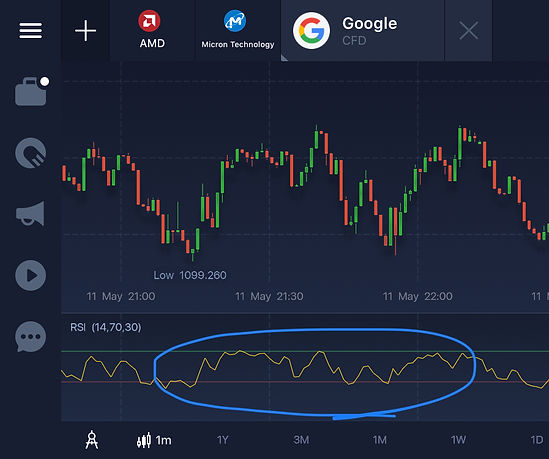
the RSI indicator
Like the ATR Indicator, and the Parabolic SAR, the RSI was also developed by Welles Wilder. Wilder was an American real estate developer, engineer, and famous technical analyst. It first came to light in 1978 after it appeared in his best-selling "New Concepts In Technical Trading Systems".
RSI stands for Relative Strength Index, and it's a momentum oscillator used to measure the speed and magnitude of price movements.
Watch this short 90-second video to learn a little more on this amazing indicator.

Before we continue, make sure you download the IQ Option platform so that you can test out this indicator. You get a FREE $10,000 practice account with it.
RISK WARNING: YOUR CAPITAL MAY BE AT RISK
how to interpret the rsi
As you may have learnt from the short video, the RSI oscillates between 0 and 100. The default settings that delineate the overbought and oversold positions are 30% and 70%. When the line is below the 30% line (oversold zone), this is when the price is expected to reverse, and the trend goes bullish. When it reaches crosses the 70% line, it's overbought, and most traders expect the price to drop. Some traders change the default settings to 20% and 80% for the oversold and overbought respectively. This sometimes reduces the likelihood of getting false signals. If you look at the RSI, most of the time it bounces between the 30% and 70% line, so most traders just use those.

The image above is a prime example that shows the RSI hitting the overbought region (blue circle), and the oversold (red circle). You can see that it remained overbought for quite some time, as indicated by the blue line. The price just kept going up. Remember, as a trader it's always a good idea to use more than one indicator, and in cases like this the ADX could come in handy. It measures the strength of a trend. Read more on it here.
Now, let's look at an example of the RSI remaining within the 30 and 70 'corridor'. Take a look at the image below. It does touch the 30 and 70 lines, but it generally remains within the limits.

RSI for bullish or bearish trends
The RSI can be a great indicator for determining whether the trend is bullish or bearish.
-
During a bullish market, we normally tend to see the RSI within the 40 and 90 range. The 40 to 50 zone acts as the support level in this case.
-
During a bearish, or downward market, the RSI can usually be found between the 10 to 60 range. The 50-60 zone acts as the resistance.
The RSI is used by many traders worldwide, primarily because it can tell when to BUY (CALL option) or SELL (PUT option). Use it together with other indicators to increase its accuracy.
Another way traders use the RSI to confirm a trend is by looking to see whether the line crosses the midpoint. Since 30% and 70% are used as the limits demarcating the oversold and overbought zones (respectively), that means that the 50% line lies right in the middle.
For an uptrend (bullish trend), then the RSI must be above the 50% line. Similarly, during a downtrend, the opposite is true. Look for the RSI to be below this line.

The image above clearly shows how when the RSI goes above the (imaginary) 50% line, then the trend is bullish.
Time to put it into practice. Make sure you download the IQ Option platform to start trading.
Now, let's take a look at the other indicator that Eng. Wilder developed, the Parabolic SAR.

RISK WARNING: YOUR CAPITAL MAY BE AT RISK.






